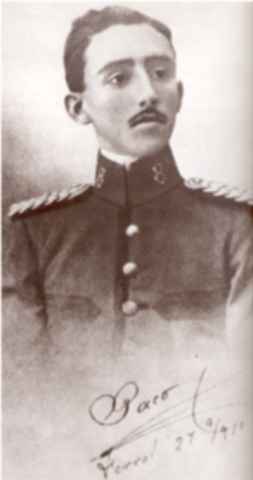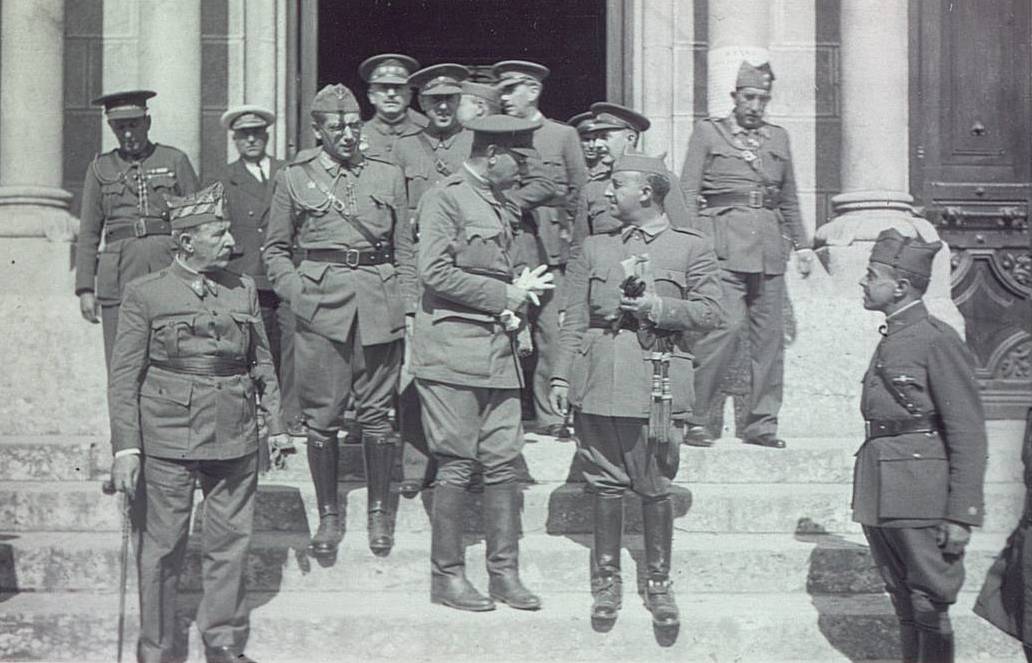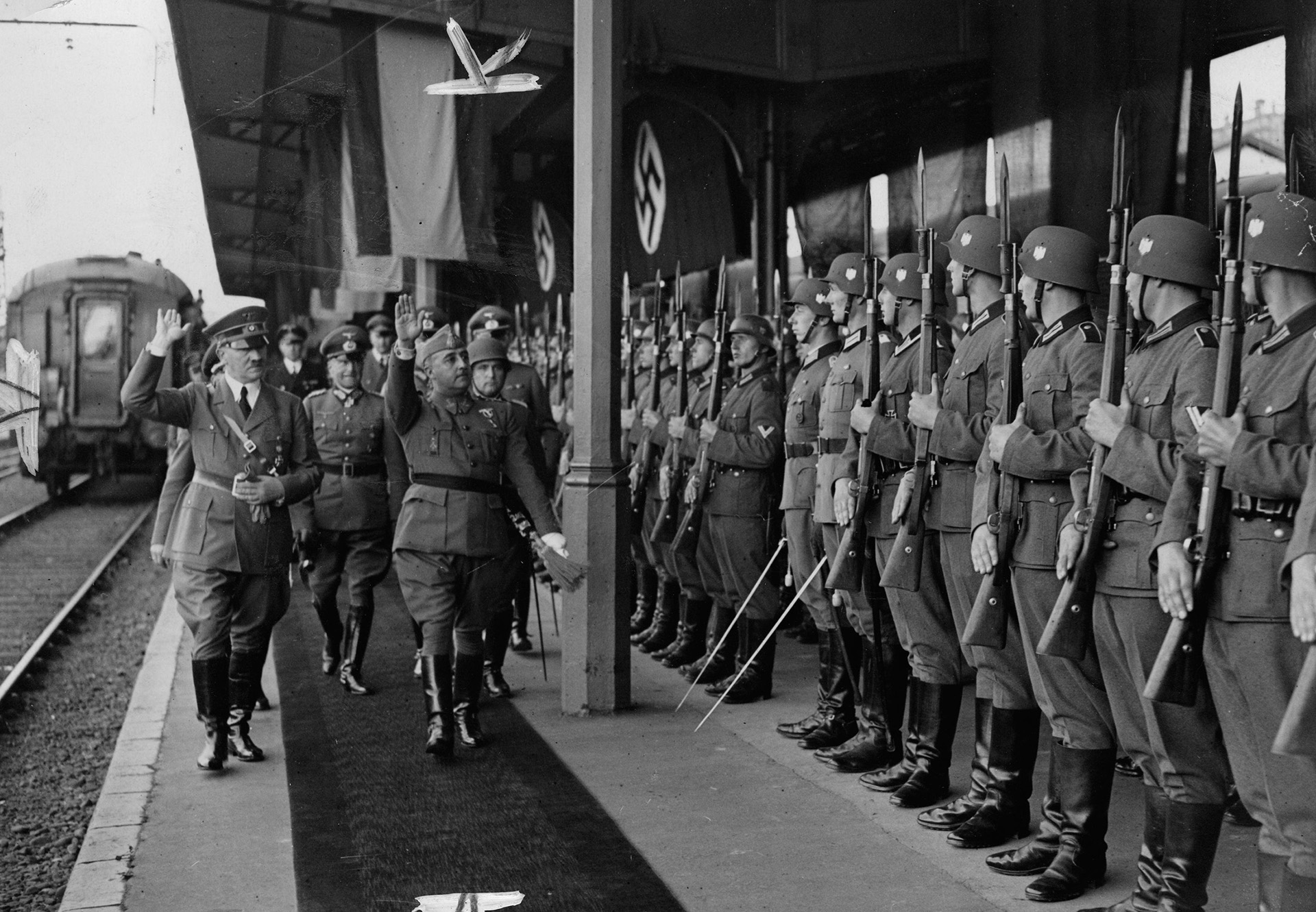10 LAWS OF TYRANNY: Francisco Franco of Spain

Hieronymus Bosch. The Temptation of St. Anthony, 1500–1510 / Art design: Olena Burdeina (FA_Photo) via Photoshop
He was the most religious of all European rulers. He restored the monarchy in Spain. He killed 450,000 Spaniards during the three-year civil war alone, yet managed to maintain neutrality in World War II, profiting from both warring sides. He tyrannized his people for 36 years. This was the Spanish general and caudillo Francisco Franco.
10 RULES OF FRANCISCO FRANCO’S RULE

RULE 1. FROM YOUTH, DREAM OF BECOMING A GENERAL
F
rancisco Franco (1892–1975) was born in the coastal town of El Ferrol in northwestern Spain into the family of a hereditary aristocrat who served in the navy with the rank of brigadier general. His mother was a traditional Catholic and had a very strong influence on Franco during his childhood.
Until the age of 12, Franco attended a private school run by a Catholic priest. Then came naval school. At 14, he entered the Infantry Academy in Toledo and graduated three years later with the rank of second lieutenant. After that, Franco found himself in the army. Following the family tradition, he decided to follow in his father’s footsteps and become a general.
RULE 2. BE A MAN OF HONOR AND AN UNQUESTIONED LEADER
In 1912, after two years of service in the quiet garrison of El Ferrol, he was sent to Melilla, a Spanish enclave in Morocco, where the Spanish were waging a bloody war against the Moroccans. The following year, Francisco received the rank of first lieutenant in the elite regiment of the local Moroccan cavalry.
The young Franco demonstrated his ability to effectively command troops, showed leadership qualities, and earned a reputation as a professionally dedicated man. He was impeccably honest… and somewhat reserved.
However, he also revealed another side of himself. Spending 11 years in Africa, he took part in punitive operations. The Legion in which Franco served was notorious for its brutality, including towards civilians. They beheaded prisoners and displayed their heads as trophies.
At the age of 33, Francisco became the youngest Spaniard to receive the rank of general. Prior to that, he had been awarded the rank of lieutenant colonel by King Alfonso XIII himself. Throughout his life, Franco remained loyal to the idea of monarchy — even when it was overthrown in 1931 and replaced by the Second Spanish Republic (1931–1939).
The republicans who won the election sought to weaken the power of the armed forces and the Catholic Church. And so Franco, as an authoritarian right-wing figure, was sent to a remote post near El Ferrol. For a time, he stepped away from politics.

RULE 3. BE RUTHLESS TOWARD THOSE DESIGNATED AS ENEMIES
In 1933, the right-wing forces won the elections. The following year, Franco transferred troops from Morocco to Asturias (in northern Spain) to suppress a leftist uprising. As a result, around 4,000 people were killed, and tens of thousands were imprisoned.
Two years later, Franco became Chief of the Army General Staff. When the left-wing coalition won the next round of elections in early 1936 and violence and political assassinations escalated, several generals began planning a coup to save Spain from the influence of communists and anarchists in the government. Franco became one of the key figures of the uprising.
The summer of 1936 marked the beginning of the civil war between republicans and nationalists. Within a year, the nationalists under Franco’s command were scoring victory after victory — partly thanks to the support he secured from Nazi Germany and Fascist Italy.
Hitler and Mussolini began supplying arms, hoping to make Franco their puppet — and at the same time to test their new weaponry on the battlefield.
But Franco continued to act independently — he secured the support of the Catholic Church, united the fascist and monarchist parties, and dissolved the rest. During the fighting, the nationalists executed tens of thousands of political prisoners. Neither the support of the Soviet Union nor the international brigades could save the Spanish republicans. German and Italian bombings helped the nationalists conquer the Basque Country and Asturias in 1937.
At the end of March 1939, Franco’s forces occupied Madrid. Barcelona had surrendered a bit earlier. On April 1, Franco declared a final and irrevocable victory. He received the rank of Generalissimo and the title «Caudillo» (from Spanish caudillo — «leader»). The cost of this title: 450,000 Spaniards killed in the civil war (nearly 2% of the prewar population). By decree of August 8, 1939, Franco became the «lifetime supreme ruler of Spain.» And from then on, he ruled the country for 36 years.

RULE 4. ENACT A LAW TO COMPLETELY DESTROY THE OPPOSITION
While political repression had previously been marked by lawlessness, it continued immediately after the end of the civil war — now on a legal basis.
The Law of Political Responsibility, enacted by Franco on February 9, 1939, allowed for the prosecution of all Spaniards who had taken part in the revolutionary movement on the republican side since 1934. Punishments ranged from imprisonment to public executions.
RULE 5. MAINTAIN NEUTRALITY IN WAR WHILE «USING» BOTH SIDES
Exactly five months after Franco’s victory in the civil war, World War II began. Hitler met with Franco in 1940. They talked for nine hours. Hitler tried to persuade Franco to join the war or at least allow German troops to pass through Spanish territory to reach Gibraltar. The Caudillo replied that for Spain to enter the war, it would need many, many tons of grain, ammunition, and artillery — and that the presence of German troops near Gibraltar would be an insult to Spanish honor…
Franco stood firm. Spain managed to remain neutral. But he did assist Hitler by assembling a volunteer unit — the «Blue Division» — and sending it to the Eastern Front as part of the Wehrmacht.
Throughout the entire war, Franco skillfully used both warring sides to his advantage. He traded profitably with Germany and Italy while also receiving aid from Britain — in exchange for his neutrality. And one more thing: during World War II, over seven thousand Jews found refuge in Spain.
RULE 6. SUPPRESS AND RULE
After the Civil War, many republicans fled the country. To try those who remained, military tribunals were established, sentencing thousands more Spaniards to death. Franco himself admitted in the mid-1940s that he had 26,000 political prisoners behind bars. He made Catholicism the only permitted religion, banned the use of Catalan and Basque languages outside the home, and forbade Catalan and Basque names for newborns. Franco also built an extensive secret police network for surveillance.
As a result, the first 20 years of Franco’s rule were marked by brutal repression of anyone who opposed or refused to support his regime. Around two million people ended up in prisons and concentration camps, and hundreds of thousands were killed.

RULE 7. UNIFY THE LIFE OF THE MASSES
The Francoist political regime was an authoritarian system with elements of military dictatorship. Franco’s Spain resembled fascist states — it embraced the ideology of «one leader, one state, one people» and adopted the «Roman salute» — raising the right arm forward and upward with an open palm. By Franco’s decree of April 27, 1937, this became the official salute for everyone except the military. In other words, the entire population was required to «Heil»… The decree was repealed in September 1945.
The country had a one-party system. The only legal party was the ruling one, called the «Spanish Falange.» All others were banned. Independent trade unions, any form of strike, and even divorce were prohibited. Censorship extended to all media, as well as art and literature.
After World War II, Spain faced diplomatic and economic isolation. Franco remained the only fascist dictator in Europe. However, as the Cold War intensified, this isolation rapidly diminished. In 1953, Spain signed an agreement with the United States, allowing the U.S. to build three air bases and one naval base on Spanish territory — in exchange for military and economic aid. In December 1955, Spain was admitted to the United Nations.
RULE 8. SECURE A MONARCHICAL FORM OF GOVERNMENT IN ADVANCE
Franco ensured the continuity of his regime well before his death through an official referendum in 1947, which declared Spain a monarchy and ratified Franco’s own authority as a lifelong regent. At the same time, the dictator announced that his successor would be a king, and in 1969, he personally chose Prince Juan Carlos de Borbón — the grandson of the last king, Alfonso XIII, who had been deposed in 1931 — for the role.
Franco announced that after his death, the prince would ascend to the throne. And that is exactly what happened on November 22, 1975 — the day after the dictator’s death. A bit earlier, in 1973, Franco stepped down as prime minister while retaining the roles of head of state and Commander-in-Chief of the armed forces.
RULE 9. BECOME THE HEAD OF AN «ECONOMIC MIRACLE»
Spain’s «economic miracle» began in 1959 with reforms introduced by young technocrat ministers brought into the government by the dictator. The «Stabilization Plan» loosened administrative control over the economy. Access to foreign capital was opened, and the peseta became a freely convertible currency. But Franco carefully ensured that liberalization applied only to the economic sphere…
In the 1960s, industrial production grew by 140 percent. Spain suddenly jumped to second place in terms of economic growth, behind only Japan, and by 1974, it ranked 10th among the world’s largest industrial nations. The national pride and symbol of this development was the SEAT automobile. Spain also became a major tourist destination.
It was during this time that the phenomenon of the middle class first emerged: a person with a stable job and income, able to support a family, buy a car, and even a house. The standard of living in wealthy Spain approached that of developed Europe.
Naturally, this new middle class viewed Franco’s dictatorship as a highly successful model. Meanwhile, the southern regions of the country, with their low levels of industrialization, hardly noticed any of this «miracle.»

RULE 10. STEP AWAY FROM POWER IN TIME
As Franco’s government became more liberal, some police powers were relaxed, and after the «economic miracle,» Franco’s image in the 1960s began to shift — from a stern Generalissimo to a milder elderly statesman.
By the late 1960s, Franco’s health had noticeably declined, but he believed that Spain’s affairs were orderly enough and that after his death, Prince Juan Carlos would preserve at least the core structure of his regime.
THE END OF THE DICTATOR
No one ever managed to overthrow him. Francisco Franco died of a heart attack on November 20, 1975. He was buried in the crypt of a mausoleum dedicated to those who died in the civil war, not far from Madrid. In his final public speech, Franco declared: «Against our country is a communist Masonic conspiracy, unrelated to the political class, which is built on red terror. They do not see the spiritual foundation that to us is honor, but to them — shame.»
In that same year, shortly before his death, suffering from Parkinson’s disease and having endured several heart attacks and surgeries, Franco remained a dictator: he continued signing death sentences for his political opponents.
He was the most religious ruler in Europe, a lifelong monarchist. Nearly half a century has passed, yet Spain still shudders as more and more horrors of the dictatorship and the dreadful legacy of Francoism come to light.
10 LAWS OF TYRANNY: Mao Zedong of China
When copying materials, please place an active link to www.huxley.media
Select the text and press Ctrl + Enter






